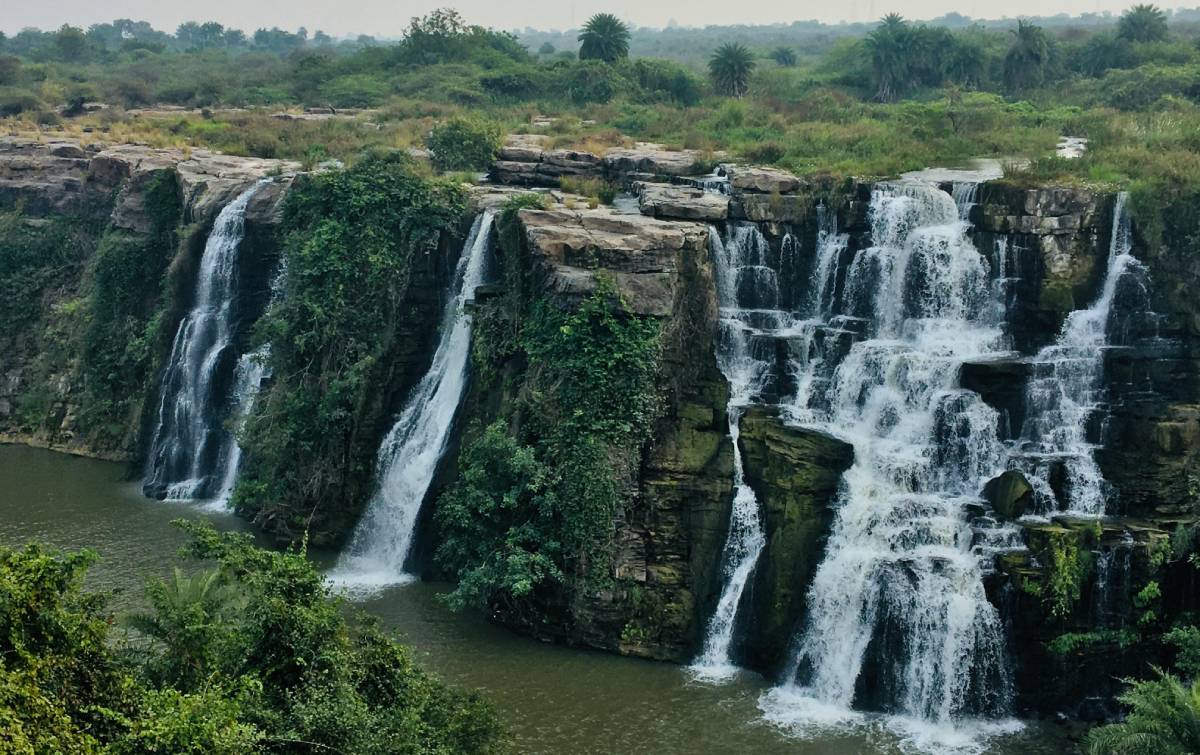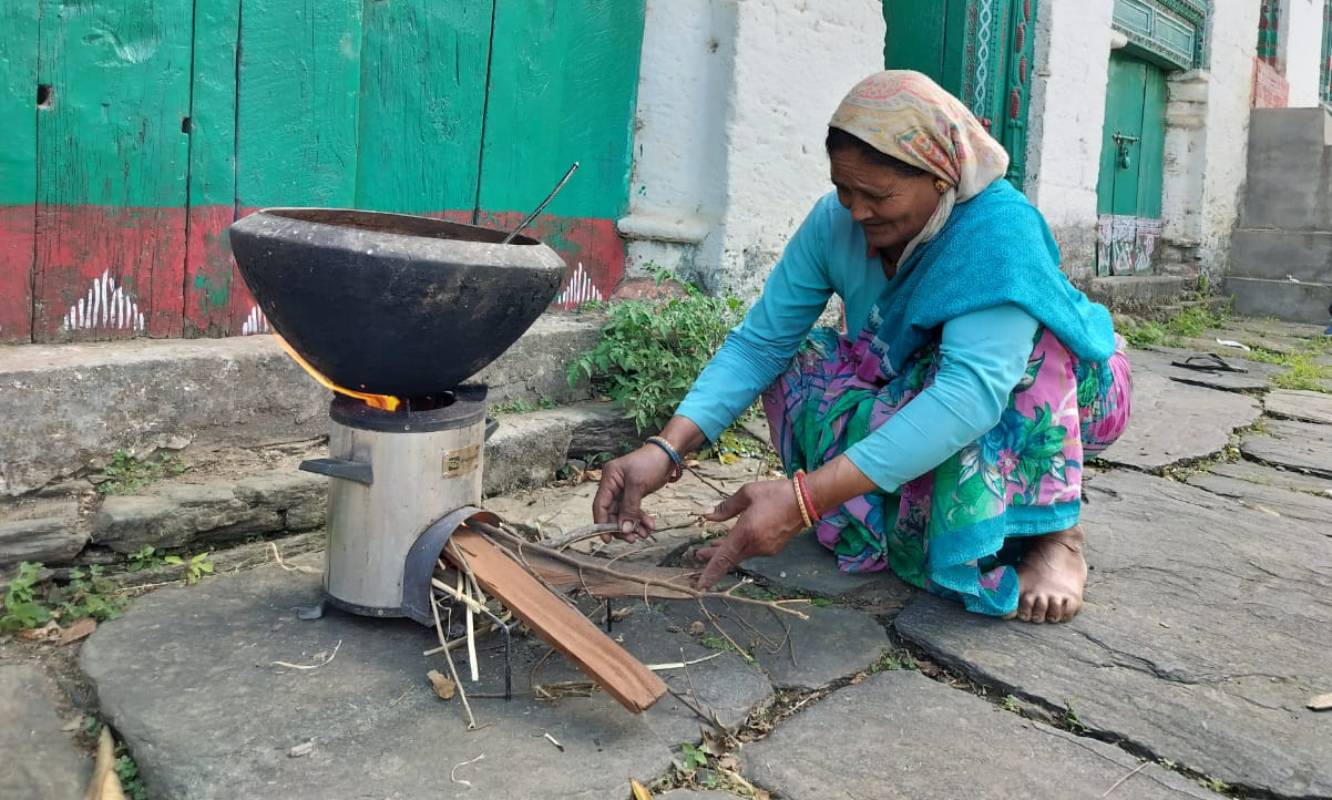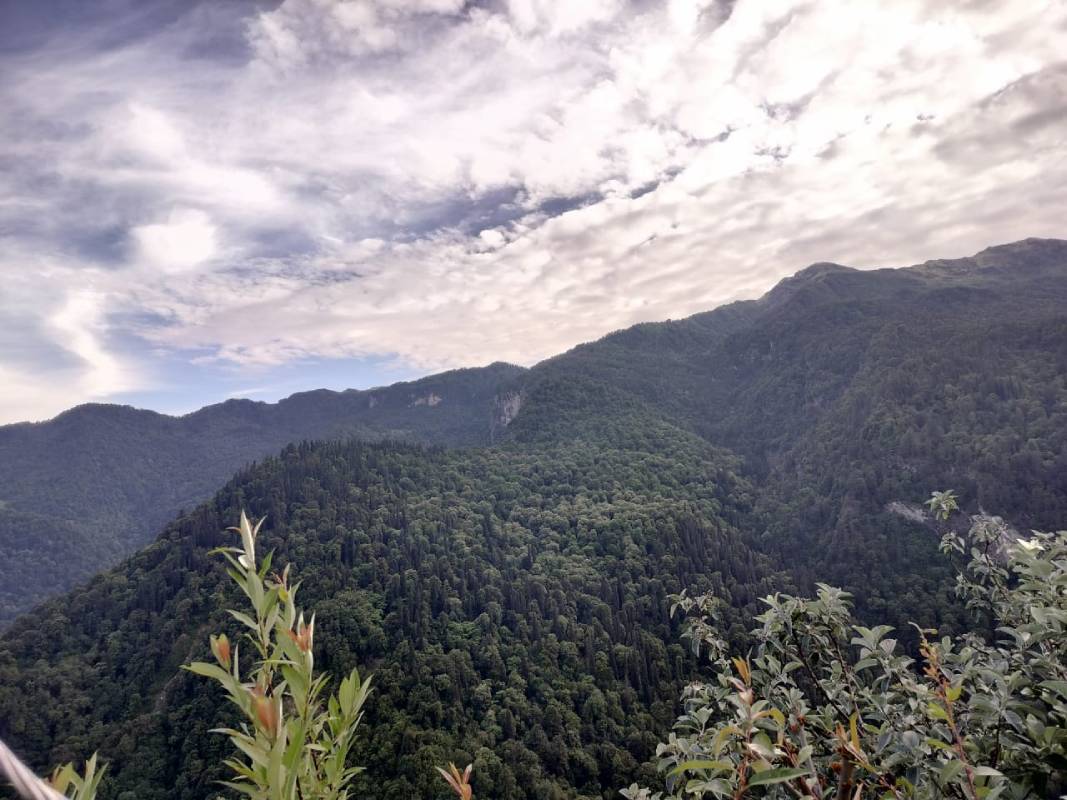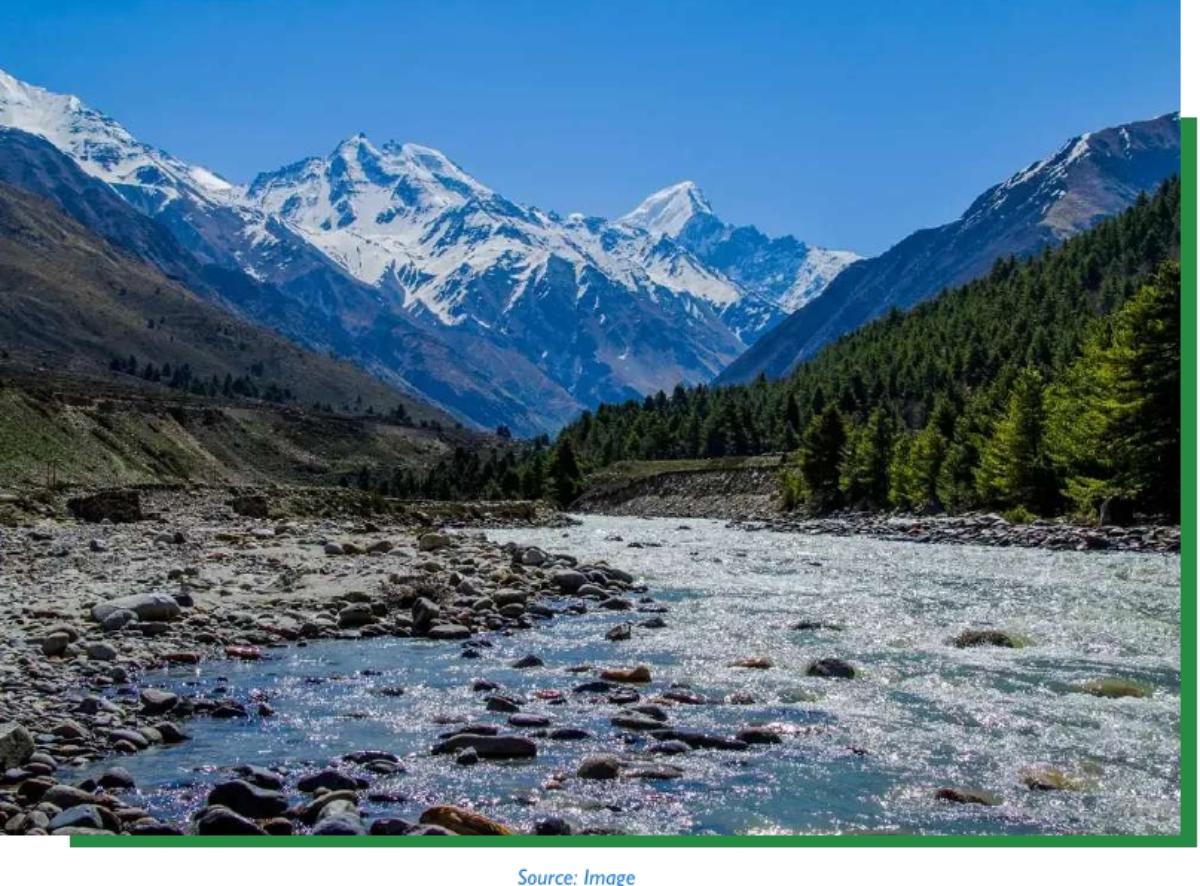The complexity and variations in hydrology, geo-hydrology, physiographic and location of Jammu and Kashmir makes the UT very diverse and endowed with numerous natural wealth ranging from lakes, rivers, forests, hills, mountains and glaciers. Such variations have also diversified social, cultural and economic life in this newly formed UT. Largely, the UT is divided into two regions namely Jammu and Kashmir. Jammu has landforms like plains, valleys and hills, which makes its soil fertile and productive for crops like wheat and maize. However, most of its agriculture is rain fed. Kashmir has high mountains, lakes and snow covered areas. Its land is fertile and suitable for production of apple, rice, maize and saffron.
The entire UT is located in the Indus river basin with hundreds of small rivers and streams feeding major rivers like Jhelum, Ravi, Chenab and Indus. Both regions have rich forested areas. These forests have been used for timber extraction as the UT forests have an abundance of trees such as Deodar, Kail, Chir and Fir. This chapter provides a brief overview of the state of the natural environment in Jammu and Kashmir.
Jal – State of Water Resources
The entire Union Territory of Jammu and Kashmir drains into the Indus river basin. It is the largest river basin in the Indian Himalayan region covering part of Himachal Pradesh, entire UTs of Jammu & Kashmir, Ladakh and part of Punjab, Haryana and Rajasthan. In total Indus basin has a total geographical area of 1081 thousand square kilometers. Further the Indus river basin is subdivided in eleven sub-basins. Of these six sub basins namely Upper Indus, Lower Indus, Jhelum, Chenab, Gilgit and Ravi are substantially part of UT of Jammu & Kashmir.
Glaciers play an important role in feeding almost all rivers in the Indus river basins. According to ICIMOD nearly 50% of river flow in the Indus basin is from glacier melt. Which is very high compared to other two major Himalayan river basins – Ganga and Brahmaputra. According to this study glacier melt contribute only 12% of river flow in Brahmaputra basin and 9% in Ganga basin[1]. Major rivers in the UT are Jhelum, Chenab, Indus, Tavi and Ravi. A large area in Jammu & Kashmir is permanently snow covered and houses hundreds of glaciers. The undivided UT of Jammu & Kashmir had nearly 60% of its geographical area under permanent snow cover. However, it has substantially decreased after bifurcation of the state.
The good precipitation (both rain and snow) keeps water resources of the state alive. According to rainfall data the UT receives more rain in Jammu division compared to Kashmir valley. The annual average rainfall of the UT is 1028 mm but it varies significantly from one district to another due to high variation in topology. District like Badgam, Bandipura, Pulwama and Srinagar receives average rainfall around 600mm. However districts like Udhampur, Reasi and Kathua receive more than 1400 mm rain in a year.
Rainfall is also unevenly distributed across the region and time. For example the Jammu region receives about 68% of its total rainfall during Monsoon as part of southwest monsoon season. In winter it receives 15% of its total annual rainfall. Further the Kashmir valley receives as much as 40% of its total annual rainfall in the pre-monsoon season. Winter rain and snowfall contribute 25% of the total rainfall in the region.
Table 1: Major Water Statistics of J&K
| Number of major river catchments | Number | 3 |
| Watersheds | Number | 440 |
| Micro-watersheds | Number | 4195 |
| Average annual Rainfall | MM | 1011 |
| Number of lakes and water bodies | Number | 565 |
| Number of villages with springs | Number | 3313 |
Source: compiled from different Govt sources
The Indus river basin drains 42,241 sq km of Jammu and Kashmir along with a large area of Ladakh, Himachal Pradesh and other states. In total the basin has a total capacity of 73,330 MCM water, out of which nearly 46,000 MCM is utilizable surface water in the form of streams, rivers, ponds and lakes. A substantial part of this water is available in Jammu and Kashmir[2].
Groundwater is not a major source of water in the union territory; however, as in any region the hydrogeology of Jammu and Kashmir play important role in ecological services. The CGWB reveals that the hydro geological set up of Jammu and Kashmir is highly complicated. Both Jammu and Kashmir region have very distinct aquifer characteristics. The hydro geological formations of the UT are broadly divided into two categories namely porous formation and Fissured formation. The maximum groundwater level in Kashmir region was 15.66 mbgl in August 2021. In Jammu region the water depth in August 2021 was in the range of 0.85 mbgl to 35.6 mbgl.
Jammu and Kashmir is also famous for its large lakes, streams and waterfalls. These water resources not only contribute to the picturesque beauty of the region but are also linked to local culture, economy and subsistence. According to the first water body census conducted in 2021 the UT has 9,765 water bodies. More than 48% of these water bodies are owned by individual, community groups and other private bodies[3]. Compared to its neighbouring state Himachal Pradesh, these numbers are very less, however, they contribute immensely to provide water for various usages. Out of these water bodies 7,493 water bodies are fully functional. Of the 7493 in use water bodies of the UT, 5986 water bodies are used for drinking water. Only 719 water bodies out of total are used for irrigation in the Union Territory.
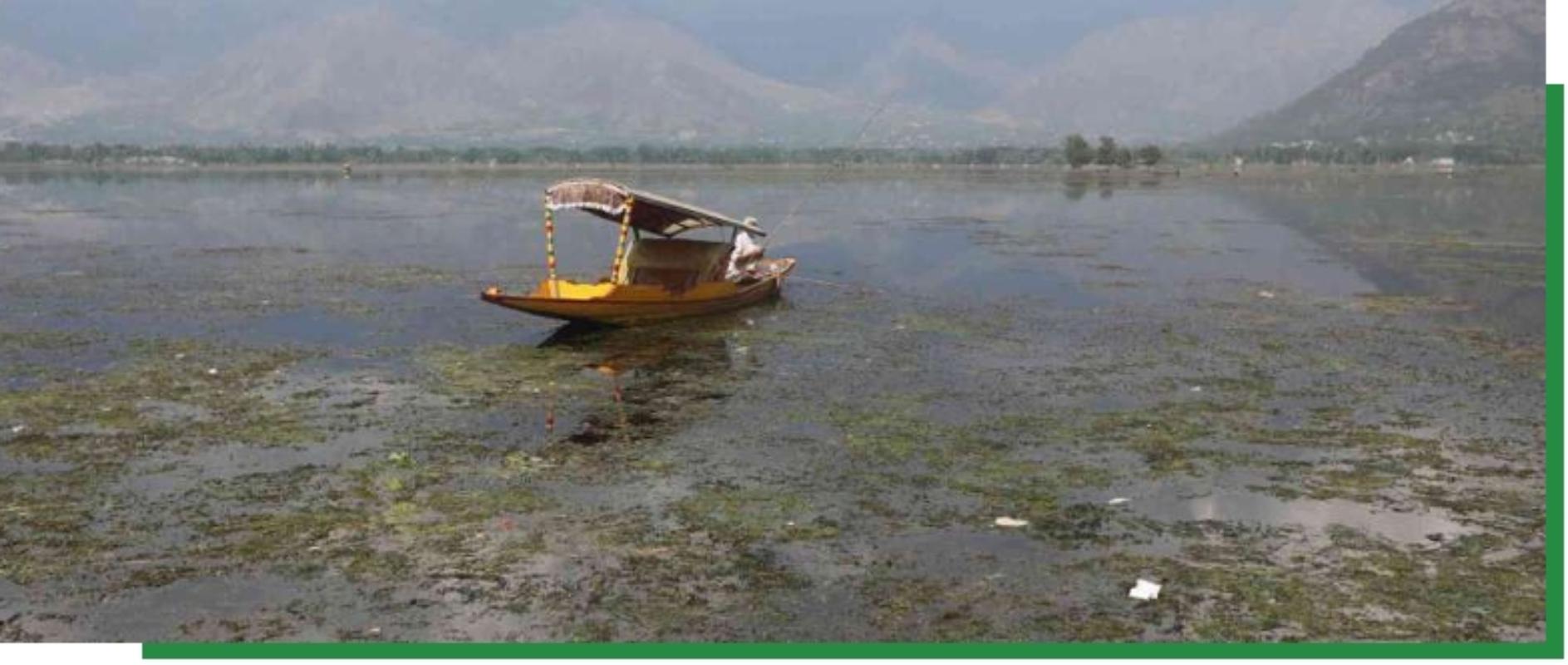
Table 2: Census of Water Bodies- J&K
| Type of Water Body | Number |
| Pond | 5256 |
| Tanks | 179 |
| Lakes | 37 |
| Reservoirs | 441 |
| Water Conservation structures | 29 |
| Other | 3823 |
| Total | 9,765 |
Source: Water Body Census, 2023
Before the nationwide census of water bodies conducted by the Union Ministry of Water Resources, the Jammu and Kashmir government had also conducted a survey of lakes and ponds in the erstwhile state of Jammu and Kashmir[4]. According to this state specific census, there are 565 lakes and ponds in the UT. Of these, 415 lakes are located in Kashmir region and 150 lakes and ponds are in Jammu division. This census report has raised concerns relating to drying of water bodies due to the number of regions. The report found that catchment areas of these lakes are highly compromised and also dumping of sewage waste in these water bodies has polluted the Lake Ecosystem.
Springs in the entire Himalayan region play an important role in rural and urban life. According to an estimate of the NITI Aayog in 2018, there are around 3 million springs in the Indian Himalayan region. The first census of springs in India reveals that about 50% villages in Jammu and Kashmir have one or more springs meeting water demands of villagers[5]. According to this census 3313 villages out of 6553 villages of Jammu and Kashmir have springs.
Jammu and Kashmir is a water surplus UT with range of water sources and abundance of permanent snow cover, glaciers, rivers, streams and lakes and groundwater aquifers. Most o the river of Indus basin passes through the UT. However, both climatic challenges and anthropogenic pressure have increased vulnerability of these water resources. The receding of glaciers in the Himalayan region and decreasing area under permanent snow cover will affect water flow in rivers. Moreover, encroachment in the catchment area of lakes and springs has threatened these two major sources of water in the UT.
Jangal – State of Forests in Jammu & Kashmir
Nearly 47.8% of the total geographical area of Jammu and Kashmir (42,241 sq km) is forest in the records of administration of the Union Territory. The total forest in the UT is 20,199 sq km out which 17,648 sq km is reserved forests. These records are based on limited reporting of land use in the UT due to number of complex issues. The Forest Survey of India has been reporting state of forest based on 38,433 sq km area of Jammu and Kashmir. The ratio of forests to the total geographical area of State/UT is relatively less in Jammu and Kashmir compared to Himachal Pradesh and Uttarakhand. However, forests in the UT have always been integral part of subsistence life and major source of income for the state. Shepherd communities of UT such as Bakarwal, Gaddi and Chopan have been using both high altitude and low altitude forests of the state for sheep rearing. They usages alpine grasslands in summer as grazing land for sheep.
Moreover, communities in both Jammu and Kashmir divisions have been using local forests for a number of minor forest products both for their subsistence life, cultural practices and commercial sale of minor forest products. More than 72% of the UT’s population lives in villages dependent largely on agriculture and allied activities such as livestock, horticulture and agricultural labour. All these occupational sectors are highly dependent on local forests and their resources. In other words as high as 70% of the population of the state have been dwelling in forests for their subsistence.
The UT of Jammu and Kashmir was formed in 2019 after bifurcation of erstwhile state of Jammu and Kashmir. There is no data to compare the state of forest in the newly carved out UT, yet based on available information of forests in Ladakh and Jammu & Kashmir, it can be argued that the UT has not observed any drastic change in its forest cover in the last two decades. The total forest cover including tree cover of Jammu and Kashmir in 2001 was 21,237 sq km, which remains same in 2023 at 21,346 sq km in 2023.
Table 3: Forest Cover in Indian Himalayan States
| State/UT | 2001
(Area in sq km) |
2023
(Area in sq km) |
||||
| Dense Forest | Open Forests | Total Forest Cover | Dense Forest | Open Forests | Total Forest Cover | |
| Ladakh | NA | NA | NA | 511.34 | 1,774.58 | 2,285.92 |
| Himachal Pradesh | 10,429.00 | 3,931.00 | 14,360.00 | 10,397.89 | 5,182.46 | 15,580.35 |
| Jammu & Kashmir | 11,848.00 | 9,389.00 | 21,237.00 | 12,215.35 | 9,131.04 | 21,346.39 |
| Uttarakhand | 19,023.00 | 4,915.00 | 23,938.00 | 17,784.21 | 6,519.62 | 24,303.83 |
| Sub Total (West Himalayas) | 41,300.00 | 18,235.00 | 59,535.00 | 40,908.79 | 22,607.70 | 63,516.49 |
| Manipur | 5,710.00 | 11,216.00 | 16,926.00 | 7,121.6 | 9,463.86 | 16,585.46 |
| Meghalaya | 5,681.00 | 9,903.00 | 15,584.00 | 9,618.65 | 7,348.19 | 16,966.84 |
| Mizoram | 8,936.00 | 8,558.00 | 17,494.00 | 8,897.28 | 9,093.18 | 17,990.46 |
| Nagaland | 5,393.00 | 7,952.00 | 13,345.00 | 5,718.19 | 6,504.28 | 12,222.47 |
| Sikkim | 2,391.00 | 802.00 | 3,193.00 | 2,659.2 | 699.2 | 3,358.40 |
| Arunachal Pr. | 53,932.00 | 14,113.00 | 68,045.00 | 50,600.41 | 15,281.16 | 65,881.57 |
| Sub Total (East Himalayas) | 82,043.00 | 52544 | 134587 | 84,615.33 | 48389.87 | 133005.2 |
| Grand Total (Himalayas) | 1,23,343.00 | 70,779.00 | 1,94,122.00 | 125,524.1 | 70,997.57 | 1,96,521.69 |
Source: ISFR, 2001 and ISFR, 2023
Deodar, Kail, Chir and Fir are major commercial tree species available in forests of Jammu and Kashmir. More than 40% of the mapped forest area in Jammu and Kashmir has these tree species. These commercially viable tree species are found in forests like Lower Chir pine forests, Himalayan chir pine forests, Moist deodar forests and blue pine forests. Himalayan Silver Fir, also known as Budul in Kashmir valley is widely used by carpenters for furniture and construction. This is the most extracted timber in the UT according to the annual report of the Jammu and Kashmir forest department, it extracted 74,000 cu.m Fir in2022-23 of worth Rs. 170.43 crore.
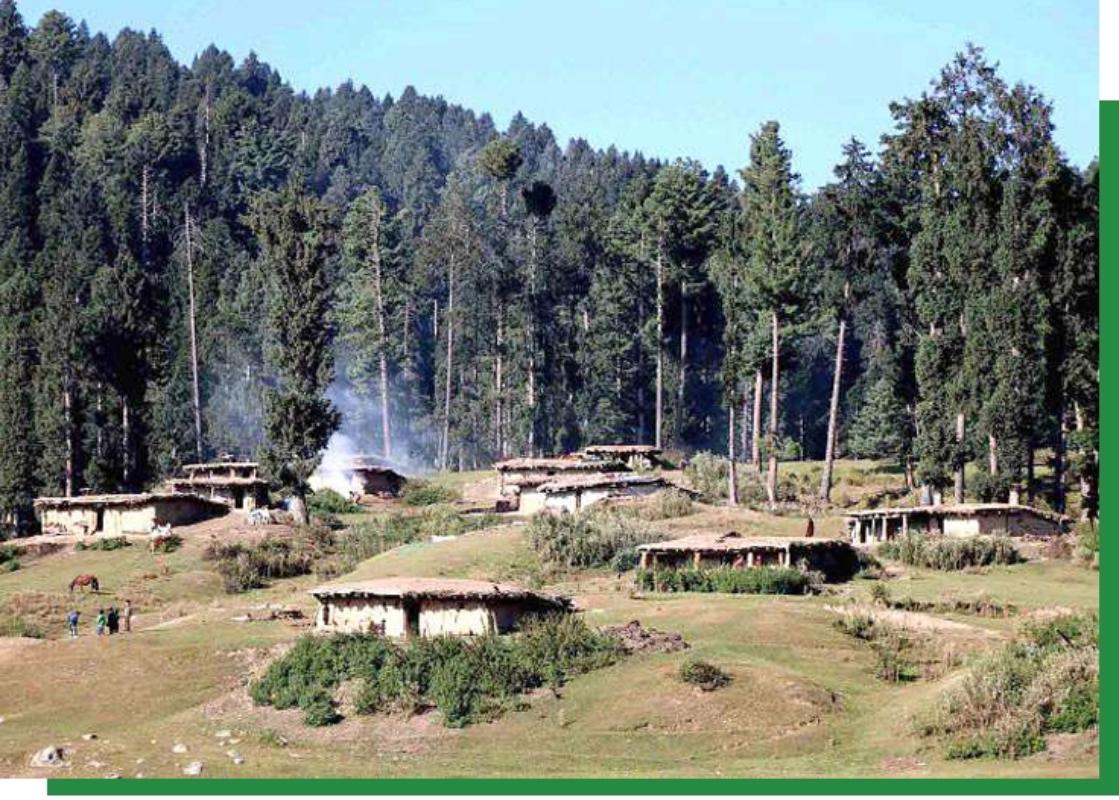
The forest department of the UT has invested a lot in planting these tree species as they have high commercial value. Moreover, it also has Northern dry mixed deciduous forest, Ban oak forest, western mixed coniferous forest, alpine and subalpine pastureland that plays a crucial role in promoting and supporting local subsistence and lifestyle. Cumulatively, these forests in the UT account for more than 36% of the total area mapped (TMA) by the Forest Survey of India (FSI) in 2023. More than 17% of the mapped area of the UT has pasture land used by traditional forest dwellers such as Chopans, Bakrwal and Gaddi as grazing land in summer.
Table 7: Forest Types in J&K
| Type | Area (sq km) | % to TMA |
| Northern dry mixed deciduous forest | 1,579.40 | 6.03 |
| Dry deciduous scrub | 419.47 | 1.6 |
| Lower or Siwalik chir pine forest | 2,609.06 | 9.97 |
| Upper or Himalayan chir pine forest | 1,094.78 | 4.18 |
| Ban oak forest (Q. incana) | 603.96 | 2.31 |
| Moist deodar forest (Cedrus) | 1,675.08 | 6.4 |
| Western mixed coniferous forest (spruce, blue pine, silver fir) | 3,557.18 | 13.59 |
| Low-level blue pine forest (P. wallichiana) | 2,168.28 | 8.28 |
| Dry deodar forest (Cedrus) | 650.22 | 2.48 |
| West Himalayan high level dry blue pine forest (P. wallichiana) | 1,271.03 | 4.86 |
| West Himalayan sub-alpine birch/fir forest | 1,426.28 | 5.45 |
| Dry alpine scrub | 606.45 | 2.32 |
| Grasslands | ||
| Himalayan Temperate Pastures | 798.28 | 3.05 |
| Alpine Pasture | 2,637.42 | 10.08 |
| Sub-alpine pastures | 1,133.77 | 4.33 |
There are discrepancies regarding the status of forest land in Jammu and Kashmir. According to the annual report of Jammu and Kashmir forest department it has 4861 sq km as protected forests. However the India’s State of Forest Report (ISFR)- 2023 published by Forest Survey of India (FSI) claims that only 2,551 sq km of forests in the UT has the status of Protected forests. The UT administration claims that it has four national parks (2430 sq km), 14 Wildlife Sanctuaries (1,754 sq km), 16 conservation area (520 sq km) and 14 wetland reserves (156 sq km)[6]. According to information provided by the UT administration, it has a sizable forest land as protected land. However, the ISFR-2023 reports that the UT has 2,551 sq km of protected forest which is just above 12% of the total forest area. The reserved forest according to the ISRF report is 17,648 sq km and there is no area under the unclassified forest.
Table 4: Forests by Category
| Forests according to Management | Area (in sq km) |
| Reserved Forests | 17,648 |
| Protected Forests | 2,551 |
| Unclassified Forests | 0 |
| Total | 20,199 |
Source: ISFR, 2023
J&K has 20,199 sq km of forest land and all of it is either protected or reserved forest. Yet, a large portion of this forest land has no forest as per records of India’s State of Forest Report (ISFR), 2023. According to this report, 7,087 sq km of forest land has no forest cover in the state. In other words more than 35% of forest land in the UT has no tree cover. This unaccounted forest land in the UT is less compared to Himachal Pradesh and Uttarakhand. A lot of this land may be under permanent forest cover and also consists of rocks and mountains therefore not suitable for vegetation. Yet, a large portion of this unaccounted forest land is without tree cover despite the possibility of vegetation.
The forest cover of Jammu and Kashmir as reported by the Forest Survey of India is 21,346 sq km in 2023. This accounts for nearly 40% of the total geographical area of the UT. However, out of this total forest cover only 13,112 sq km is on the forest land owned by the government and its agencies. The report further reveals that 8,234 sq km forest cover is outside the recorded forest area of the UT. This constitutes nearly 39% of the total forest cover in the state. The ratio of forest cover outside recorded forest in Jammu and Kashmir is significantly high compared to Uttarakhand and Himachal Pradesh. The share of forest cover outside the recorded forest in these two states is about 30% of their respective total forest cover.
Table 5: Forests as per recorded status
| Forest Status | Area in sq km |
| Total Geographical Area of J&K | 54,633 |
| Total Recorded Forest | 20,199 |
| Actual Forest Cover in Recorded Forests | 13,112 |
| Un Accounted Forests (missing forests) | 7,087 |
| Actual Forest cover in Forest outside Recorded Forests | 8,234 |
| Total Tree Cover | 3,666 |
Source: ISFR, 2023
The formation of UT and bifurcation of erstwhile state has changed the administrative system and political boundary of Jammu and Kashmir in 2019. Moreover, disputes on international boundaries and illegal occupation of Pakistan in certain parts of Jammu and Kashmir makes the situation very complicated to assess data, especially data related to land and forests. Because of these reasons we don’t have old time series data to compare the status of forests in Jammu and Kashmir. However, the available data from 2001 onwards reported in different ISFR reports suggest that there has been no significant change in the total area and quality of the forest in this UT.
Table 6: Quality of Forest inside recorded forests in J&K
| Year | Total Forests
(in sq km.) |
Dense Forest (Canopy Density more than 40%)
(in sq km.) |
Open Forest (Canopy density between 10 to 40%)
(in sq km.) |
| 2019 | 13239 | 8407 | 4832 |
| 2021 | 13111 | 8426 | 4685 |
| 2023 | 13076 | 8424 | 4652 |
Compiled from ISFR, 2019, 2021, 2023

Unlike in Himachal Pradesh and Uttarakhand, where the canopy density of dense forests is gradually deteriorating, forests of Jammu and Kashmir remain almost static despite a high level of extraction for timber and other minor forest produce. From 2019 to 2023 for which we have UT specific forest data, there is negligible fluctuation in quality and quantity of forest cover in Jammu and Kashmir.
Commercialization of forests and minor forest products in Jammu and Kashmir is very common. The UT administration earns huge revenue from sale of timber, firewood, resin, grazing fee and minor forest produce. In timber trees like pine, fir and deodar are extracted at large scale every year. A lot of it is also exported through forest Development Corporation. Moreover, firewood is also commercialized both for industrial use and domestic purposes. Minor forest produce like resin, harar, bamboo, jamun, curry leaf, arjun tree, amla and camphor are extracted and sold. The sale of firewood has been a major source of income for the state in the last five years. In the year 2022-23, it received Rs. 924 lakh.
Table 7: Forest Resources Extracted
| Forest Resources | 2018-19 | 2019-20 | 2020-21 | 2021-22 | 2022-23 |
| Rs. in Lakh | |||||
| Timber | 119.63 | 130.38 | 112.07 | 165.13 | 244.36 |
| Firewood | 266.59 | 285.2 | 332.2 | 386.45 | 924.15 |
| Resin | 0 | 0.03 | 835.8 | 52.65 | 0.30 |
| Minor Forest Produce | 186.68 | 43.09 | 18.19 | 17.9 | 52.65 |
| Grazing Fee | 7.92 | 247.99 | 9.05 | 9.44 | 8.22 |
https://www.jkforest.gov.in/assets/pdf/publications/Handbook%202022-23%20Final%2016%20march-1.pdf
The Jammu and Kashmir Forest Development Corporation (JKFDC) founded in 1978 has a variety of roles to sustainably extract forest resources in the UT. Its function includes removal of fallen wood from forests, exploitation of forest resources and undertaking research programs related to forest and forest products. However, as per the latest audit report of C&AG, the entity is only undertaking function of removal of trees from forests and carrying out sale of timber[7]. For this function, the JKFDC pays a handsome royalty to the UT government. From 2020-21 to 2022-23 the JKFDC paid Rs. 400 core as royalty to the forest department[8].
Table 8: Status of Claim under Forest Rights Act, 2006
| Claims | Individual | Community | Total |
| Claim Received | 32,207 | 10,224 | 42,431 |
| Claim Distributed | 315 | 4190 | 4505 |
| Claim Rejected | – | – | 33,187 |
The size of commercial activities of the forest department in Jammu and Kashmir reveals the importance of this sector in local livelihood. Thousands of families are involved in commercial activities related to forestry in the UT. Apart from commercialization, forests are also very integral to the local subsistence. The UT of Kashmir is the only federal government in the western Himalaya, which showed interest in distributing forest land and its resources as per the Forest Rights Act, 2006. After converting Jammu and Kashmir into a Union Territory, the union government extended the Forest Rights Act to the UT. Within a period of two years, it awarded 4,505 titles to local forest dwellers. Out of this 4,190 titles were distributed as community forest rights. Only 315 titles were awarded to individuals. However, the administration had rejected 33,187 claims out of a total 42,431 claims received in different districts. While the number of claims distributed by the UT administration looks very little, it is the highest number of titles distributed by any federal government in the Western Himalayan region.
Jameen: State of Land in J&K
Jammu and Kashmir is divided into two major regions Jammu and Kashmir. Both of these regions of the UT have significant differences in terms of ecological diversity and agro-ecological characteristics. Jammu is a larger region which comprises 62% of the total geographical area of the UT and Kashmir accounts for 38% of the total geographical area. The Jammu division is divided into two sub agro ecological zones namely low altitude subtropical zone and mid to high altitude intermediate zone. The low altitude subtropical zone lies between 300m to 1350 m above sea level and covers the area of Kathua, Udhampur, Poonch and Rajouri district of the division. Paddy, Maize, Oat and Wheat are common crops in this zone along with cow, buffalo and sheep as common livestock. The other agro ecological zone of the Jammu region is mid to high altitude intermediate zone. This zone lies between 800m to 1500m above sea level and covers areas of Doda, Poonch,Rajouri, Udhampur and Kathua district of Jammu division. In addition to wheat and maize, this zone is also good for cultivation of barley and oilseeds. Cow and Buffalo are common livestock in this zone.
Table 9: Agro Ecological Zones of J&K
| Agro Ecological Zone | Region | Area |
| Low altitude subtropical zone | Jammu | Jammu district and lower parts of Kathua, Udhampur, Poonch and Rajouri districts. Maximum rainfall is received during July-September. The mean height above sea level ranges from less than 300 m to nearly 1350 m. |
| Mid to high altitude intermediate zone | Jammu | It encompasses all the areas above outer hills, including the districts of Doda, Poonch, parts of Rajouri, Udhampur and Kathua. The zone varies in elevation from 800 to 1500 m masl in mid altitude and upto 4000 m masl in higher altitude. |
| Mid to high altitude temperate zone | Kashmir | The plain valleys have an altitude of 1560 m masl, which rises to 1950 m in low altitude Karewas in mid belts, 2400 – 3000 m in the upper belts and to 4200 m in snow bound areas. The soils of Kashmir valley are alluvial 4 in nature with irrigated area of about 62 percent. |
https://www.jkapd.nic.in/pdf/agendaa.pdf
The entire Kashmir division is part of the Mid to high altitude temperate zone lying between 1560m to 4200m above sea level. This region has plain areas good for cultivation of paddy along with maize, oilseeds, temperate fruits, almond and saffron. As high as 62% of cultivable land in Kashmir has irrigation facilities that support massive paddy cultivation in the region. A substantial portion of the Kashmir region is snowbound with no vegetation.
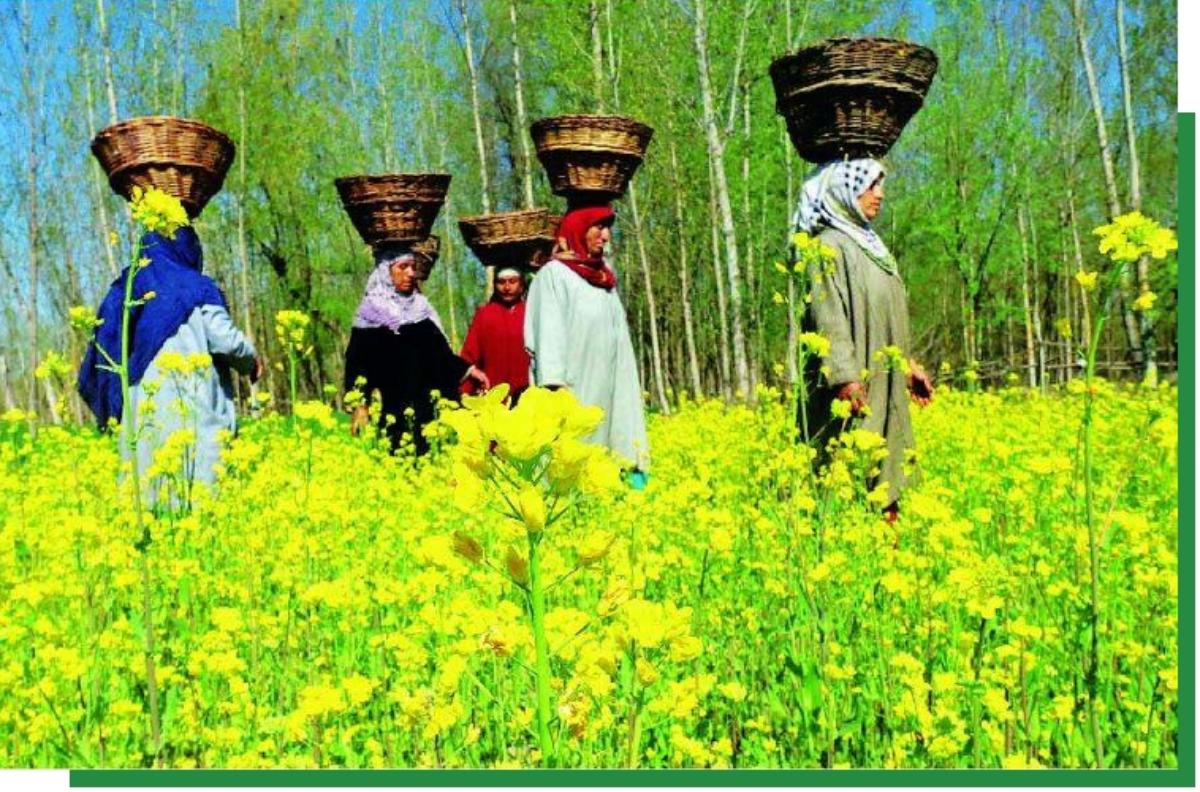
Jammu and Kashmir has not changed in terms of its land use pattern in the last 2-3 decades. In 2022-23 the net sown area of Jammu and Kashmir was 733 thousand hectare, which accounts for 31% of the total reported area (2364 thousand hectare). The net sown area in 1998-99 was also 30% of the then total reported area (2381 thousand hectare). The land under two or more crops has also not changed in the UT. The data reveals that the total cropped area has marginally increased from 1061 thousand hectare in 1998-99 to 1133 thousand hectare in 2022-23.
Table 10: Classification of Land of J&K (000 Hectare)
| Year | Land Not available for Cultivation | Other Uncultivated Land Excluding Fallow Land | Total Fallow Land | Net Area Sown | Cropped Area | ||
| Area under Non Agricultural Use | Barren and Unculturable Land | Total | |||||
| 1998-99 | 286.8 | 261.5 | 548.4 | 326.8 | 102.6 | 715.2 | 1061.8 |
| 2018-19 | 261.1 | 308.2 | 569.2 | 328.7 | 157.3 | 713.1 | 1123.8 |
| 2022-23 | 214.5 | 301.6 | 516.2 | 333.4 | 135.5 | 733.2 | 1133.4 |
https://data.desagri.gov.in/weblus/classification-of-area-report-web
Unlike Himachal and Uttarakhand, two major states in the Western Indian Himalaya, the land use in Jammu and Kashmir remains more or less same in the last 2-3 decades. In the other two states, data reveals that the net sown area has been gradually decreasing. Moreover, in those states the fallow land is increasing. However, the data reveals a completely different picture of Jammu and Kashmir, where agriculture has not declined.
The NSSO report found that there are 12.55 lakh families in the UT dependent on agriculture. However, like in other Himalayan states, the land holding is very small. Nearly 55% agricultural households of the UT have land below 0.f4 hectare. Marginal farmers having land in between 0.4 to 1 hectare, accounts for nearly 36% of the total households in the UT. Eight percent of households are small farmers and just 1% households have land above 2 hectares. Data shows that there is no household in the entire state that has land above 4 hectares.
Table 11: Distribution of Operational Holdings in J&K 2018-19
| Size of holding in ha | No of Agricultural households | As % of total | No of Non- Agricultural households | No of All rural households | Income in Rs per month (2018-19) per household |
| <0.01 (landless) | 00 | 0% | 123,495 | 123,188 | 00 |
| 0.01 -0.4 (sub-marginal) | 688,124 | 54.8% | 308,305 | 995625 | 18,844 |
| 0.41-1.0 (marginal) | 450,796 | 35.9% | 0 | 450563 | 18,750 |
| 1.01-2.0 (small) | 104,223 | 8.3% | 0 | 104625 | 19,944 |
| 2.0-4.0 (medium) | 12,557 | 1% | 0 | 13500 | 17,005 |
| > 4.0 (large) | 00 | 0% | 0 | 0 | 33,573 |
| Total | 12,55,700 | 100% | 431,800 | 1687,500 |
Source: (NSS Report no 587, Land p. A-90-93, pdf p 270, Income at p. A-886, pdf p 1064)
Of the total rural households in the state, there are around 26% households who are not dependent on agriculture. Of this more than 18% households possess land from 0.01 to 0.40 hectare. Of total as many as 7.2% households are landless and all other households are in the category of marginal, small and medium farm holding households. The income from farm across farming categorization is similar. All households irrespective of their land holding earns between Rs. 17,000 to Rs. 19,900 in a month.
Table 12: Area under principal crops in J&K (in thousand hectares)
| Year | Millets | Pulses | Food Grains | Fruits | Vegetable |
| 2004-05 | 360 | 31 | 889 | 1217 | 843 |
| 2009-10 | 357 | 30 | 936 | 1534 | 1374 |
| 2014-15 | 335 | 24 | 957 | 1779 | 1395 |
| 2019-20 | 294 | 17 | 836 | 2541 | 1337 |
| 2022-23 | 301 | 18 | 878 | 2721 | 1996 |
As discussed above the land use pattern in Jammu and Kashmir has not changed in the last two to three decades. However, there are visible changes in agricultural production in the state. The Jammu region has more agricultural land which has been producing wheat as the main crop. On the other hand Kashmir valley has comparatively less agricultural land and it produces paddy as main crop. As given in the table above, we observe that the area under millet production has decreased from 360 thousand hectare in 2004-05 to 301 thousand hectare in 2022-23.
The reduction in area under pulses and food grains has also decreased in the last two decades like millets. However, the area under fruit and vegetable production has increased substantially from 2004-05 to 2022-23. The area under fruit production has increased by more than 100% from 1217 thousand hectare to 2721 thousand hectare. The area under vegetable production has also increased in these two decades by more than 100%.
The use of chemical fertilizer in Jammu and Kashmir is relatively less compared to its use in Uttarakhand. However, compared to Himachal Pradesh, use of chemical fertilizers in the UT is very high. The positive side of UT is that its chemical fertilizer consumption is not increasing as it is observed in Himachal Pradesh and Uttarakhand. Currently, the total fertilizer consumption of the UT is 120 kg per hectare.
Table 13: Fertilizer Consumption per Unit of Gross Cropped Area in J&K
| Year | Nitrogenous (N) (kg/ha) | Phosphatic (P) (kg/ha) | Potassic (K) (kg/ha) | Total (NPK) (kg/ha) |
| 2012-13 | 75.8 | 24.1 | 9.75 | 109.68 |
| 2019-20 | 50.8 | 16.8 | 11.1 | 78.84 |
| 2021-22 | 85.4 | 21.6 | 13.0 | 120.07 |
Agricultural Statistics India- At a Glance: https://desagri.gov.in/
Other challenges the soil of Jammu and Kashmir is facing is land degradation and desertification. As per Land degradation and desertification atlas prepared by Space Application Centre in 2016 more and 35% of undivided Jammu and Kashmir was under degradation and desertification. The area under degradation has increased from 33.92% in 2003 to 35.8% in 2026. In parts of current Jammu and Kashmir UT major reasons of land degradation are loss of vegetation and water erosion.
Jalvayu Parivartan – Climate Change in J&K
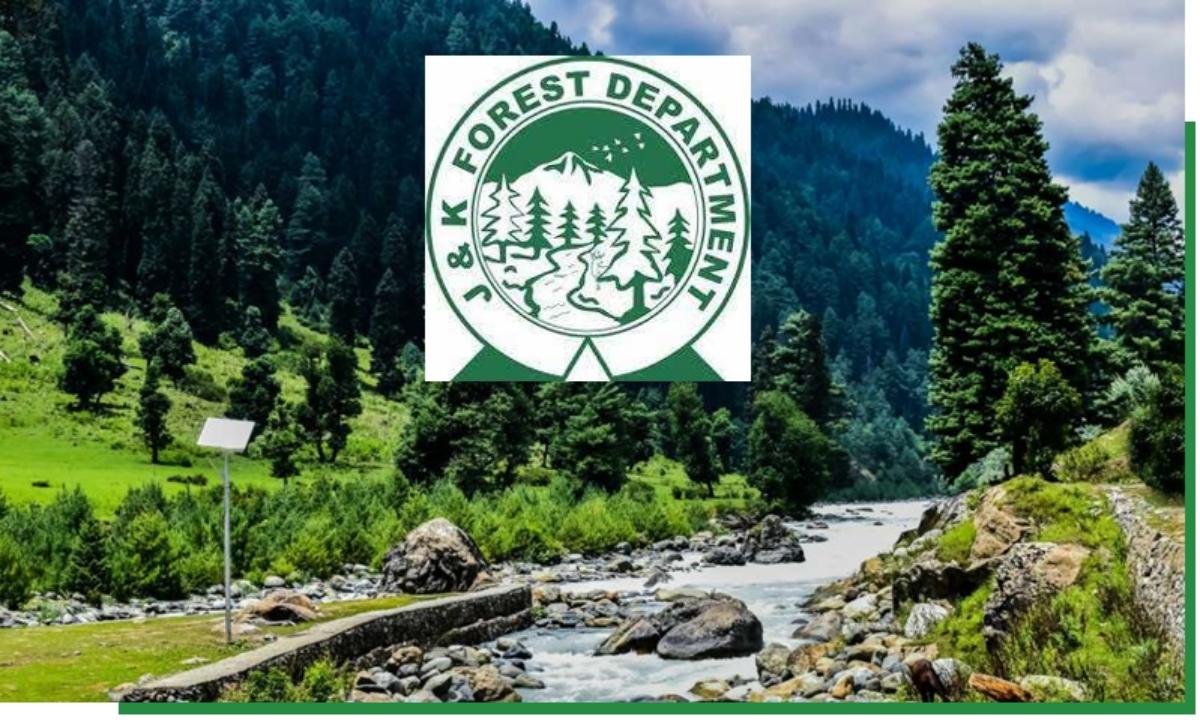
The Union Territory of Jammu and Kashmir is divided into two major topographies namely Jammu and Kashmir. Within these two topographies, a range of landforms such as valleys, plains, rivers, lakes, mountain ranges and high altitude peaks makes the entire UT highly climate diverse. In general the year may be divided into four seasons. The winter season is from December to February followed by the pre-monsoon season from March to May. Monsoon season is from June to September and the period between October and November is post monsoon season.
The UT has two climatic zones corresponding to its topographical division. Kashmir Valley is temperate and Jammu region has subtropical climatic zone. Jammu region is a combination of plains, valleys, hills and mountains. Mountains and hills in this region are part of Pir Panjal and Shivalik ranges. Kashmir valley is situated between Pir Panjal and western end of the great Himalaya ranges. The Himalayan range stops monsoon winds from southeast and south and cold winds from central Asia.
The topography and variety of land form leads to high variation in temperature of the UT. It ranges from soaring heat in summer especially in the region of Jammu to very cold in winter and permanently snow covered mountain ranges in Kashmir valley. In Jammu region, the southern part is hottest in the state, but as we move upwards towards the north and eastern part of Jammu division, due to Shivalik range, the temperature goes down. The mean temperature of Jammu division is around 13 degree centigrade which ranges from 19 degree centigrade in south Jammu to 10 degrees in northern and eastern Jammu division.
Kashmir Valley is colder compared to Jammu division. The mean temperature of the Kashmir division is 5 degree centigrade, which ranges from 6 degrees centigrade in valleys to 1 degree centigrade around high altitude mountains. Winter is very cold, when the mean temperature is about -5 degree centigrade. The temperature increases steadily from March to July.
Jammu and Kashmir receives more than 100 cm precipitation in a year. However it is highly erratic and disproportionately distributed between Jammu and Kashmir divisions. The Jammu division receives more rain compared to Kashmir valley. The average annual rainfall in Jammu division is more than 200 CM. The Jammu region receives 68% rain in the south east monsoon season. However, the Kashmir valley receives its highest precipitation (40%) during pre-monsoon season[9]. In total, UT has nearly 60 rainy days in a year. Number of rainy days in district like Katra, Gulmarg and Pahalgam is more than 100 days[10].
Drought is also very common in Jammu and Kashmir. Districts like Samba, Srinagar, Jammu, Ganderbal, Anantnag and Baramulla have a history of occurrence of drought more often. The Baramulla district has faced more severe droughts since 1951. In these years, in five different years, it observed more than 50% rain deficit. Excessive rain in the UT is also frequent. In the last 6 decades districts like Baramulla, Kathua, Kishtwar, Kulgam, Samba have had a history of excessive rain.
Climate change has started drastically affecting the natural, social and economic wealth of the Union territory. According to the Climate Change Action Plan of the UT, out of the total 7,997 glaciers in the UT, the majority of them are degrading at a very high pace. Moreover, the report claims that the snow fall has decreased to just 0.6m from 3 meter 40 years ago[11]. Other visible impacts of climate change are related to erratic weather, decreasing snowfall adversely affecting production of apples and rain fed agriculture.
[1]https://lib.icimod.org/record/28401
[2]https://www.cgwb.gov.in/old_website/GW-Assessment/GWR-2022-Reports%20State/Jammu%20_%20Kashmir.pdf
[3]https://cdnbbsr.s3waas.gov.in/s3a70dc40477bc2adceef4d2c90f47eb82/uploads/2023/04/2023040672.pdf
[4]https://ssdi.jk.gov.in/profiles/dkan/themes/nuboot_radix/templates/page/homepage/Directory%20of%20Lakes%20&%20Waterbodies%20of%20J&K%20State.pdf
[5]https://ifcjmu.gov.in/PPT_pdf/1st%20Springs%20census%2020-08-2023.pdf
[6]https://www.jkforest.gov.in/assets/pdf/publications/Handbook%202022-23%20Final%2016%20march-1.pdf
[7]https://cag.gov.in/uploads/download_audit_report/2020/11-Chapter%206%20TBA%20on%20JKSFC-0624fc828a883a5.18976848.pdf
[8]https://www.jkforest.gov.in/assets/pdf/publications/Handbook%202022-23%20Final%2016%20march-1.pdf
[9]https://diragrijmu.nic.in/CSS%20GUIDELINES/FINAL_CLIMATE%20OF%20JAMMU%20AND%20KASHMIR_e%20book.pdf
[10]https://jkplanning.gov.in/pdf/Digest%20of%20Statistics%202021-22.pdf



